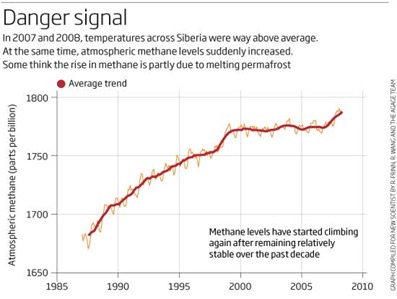Graph of the Day: Atmospheric Methane, 1985-2009
by Fred Pearce, environment correspondent for New Scientist “I AM shocked, truly shocked,” says Katey Walter, an ecologist at the University of Alaska in Fairbanks. “I was in Siberia a few weeks ago, and I am now just back in from the field in Alaska. The permafrost is melting fast all over the Arctic, lakes are forming everywhere and methane is bubbling up out of them.” Back in 2006, in a paper in Nature, Walter warned that as the permafrost in Siberia melted, growing methane emissions could accelerate climate change. But even she was not expecting such a rapid change. “Lakes in Siberia are five times bigger than when I measured them in 2006. It’s unprecedented. This is a global event now, and the inertia for more permafrost melt is increasing.” … The danger is that if too much methane is released, the world will get hotter no matter how drastically we slash our greenhouse gas emissions. Recent studies suggest that emissions from melting permafrost could be far greater than once thought. And, although it is too early to be sure, some suspect this scenario is already starting to unfold: after remaining static for the past decade, methane levels have begun to rise again, and the source could be Arctic permafrost. What is certain is that the Arctic is warming faster than any other place on Earth. While the average global temperature has risen by less than 1°C over the past three decades, there has been warming over much of the Arctic Ocean of around 3°C. In some areas where the ice has been lost, temperatures have risen by 5°C. This intense warming is not confined to the Arctic Ocean. It extends south, deep into the land masses of Siberia, Alaska, Canada, Greenland and Scandinavia, and to their snowfields, ice sheets and permafrost. In 2007, the North American Arctic was more than 2°C warmer than the average for 1951 to 1980, and parts of Siberia over 3°C warmer. In 2008, most of Siberia was 2°C warmer than average (see map). …
